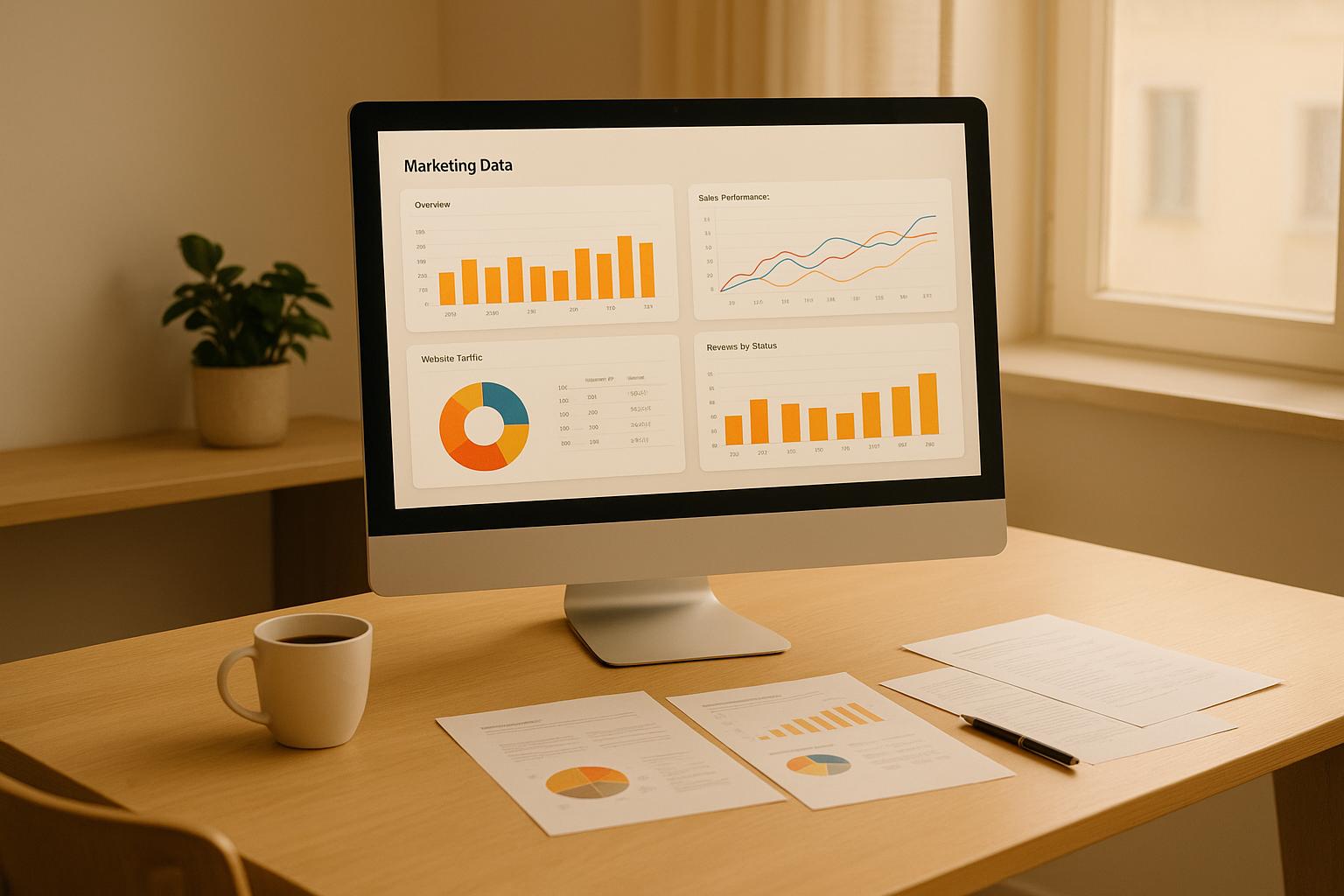Choosing between Google Analytics and Adobe Analytics depends on your business size, data needs, and budget. Here's a quick overview:
- Google Analytics: Best for small to medium businesses. It's free (up to 10M monthly page views), easy to set up, and integrates seamlessly with Google's ecosystem. Data retention is limited (14-26 months), and customization options are basic.
- Adobe Analytics: Ideal for large enterprises. Offers advanced customization, indefinite data retention, and comprehensive cross-device tracking. It requires a higher budget (around $100K/year) and technical expertise to set up and use effectively.
Quick Comparison
| Feature | Google Analytics | Adobe Analytics |
|---|---|---|
| Cost | Free (up to 10M page views) | ~$100,000/year |
| Data Retention | 14-26 months | Indefinite |
| Ease of Use | Easy to learn | Steep learning curve |
| Customization | Basic | Advanced |
| Best For | Small to medium businesses | Large enterprises |
| Integration | Google tools | Adobe Marketing Cloud |
Key Takeaway: Use Google Analytics for simplicity and cost-effectiveness; choose Adobe Analytics for deeper insights and long-term data analysis if your business has the resources.
Related video from YouTube
Features and Capabilities
Let's break down what each platform brings to the table and how they stack up against each other.
Data Collection and Reporting Features
Google Analytics keeps things simple with ready-to-use reports covering the basics - how many people visit your site, how long they stay, and whether they convert. It's perfect if you want quick insights without diving into complex settings.
Adobe Analytics steps things up with enterprise-level muscle. Want to know why your numbers suddenly changed? Their contribution analysis has you covered. Plus, you can build custom reports that dig into specific questions about your business.
Here's something interesting about data storage:
"Adobe Analytics stores customer-level data indefinitely by default, compared to Google Analytics' standard 14-month retention period, making it particularly valuable for long-term trend analysis and historical data mining."
Let's compare the key differences:
| Feature | Google Analytics | Adobe Analytics |
|---|---|---|
| Data Retention | 14 months standard | Indefinite |
| Custom Reports | Basic customization | Advanced customization |
| Cross-device Tracking | Limited | Comprehensive |
| Attribution Modeling | Standard models | Advanced custom models |
Real-Time Data Analysis
Need to track what's happening RIGHT NOW on your site? Both platforms can help, but they do it differently.
Adobe Analytics processes data faster and shows you detailed views of how users interact across different channels. It's like having a high-powered microscope for your website traffic.
Google Analytics shows you who's active and what they're doing, but it's more like a basic traffic camera - you'll see what's happening, but won't get all the fine details that Adobe offers.
Audience Segmentation Options
Think of Adobe Analytics as a master chef's kitchen - you can slice and dice your audience data any way you want. Mix behaviors across channels, stack different segments, and create complex sequences of user actions.
Google Analytics is more like a well-equipped home kitchen - it handles the everyday stuff well. Want to group users by device type, location, or how they found your site? No problem. It's perfect for businesses that don't need fancy segmentation tricks.
While Adobe lets you create complex audience recipes, Google Analytics focuses on serving up the most-used ingredients in an easy-to-use package. For most businesses, that's exactly what they need.
Costs and Scalability
Let's break down how much Google Analytics and Adobe Analytics cost, and which one fits your business best.
Pricing Details
Google Analytics won't cost you anything if you're tracking up to 10 million page views monthly per site. This free tier works great for most small and mid-sized businesses.
"The free version of Google Analytics handles up to 10 million page views monthly per site"
Adobe Analytics takes a different path - they're all about enterprise clients. You won't find their prices listed publicly, but expect to pay around $100,000 per year. That's because they build custom solutions for big companies with specific needs.
Suitability for Different Business Sizes
Here's the deal: pick the tool that matches what you need right now. Google Analytics is perfect if you mainly want to track website traffic and see how well your conversions are doing. Plus, it works like a charm with Google Ads and Search Console - super handy if you're already using Google's tools.
Adobe Analytics? That's the heavy hitter for big companies that need to dig deep into their data. Small businesses might find it too much, but it's exactly what larger companies need when they:
- Want to track users across different channels
- Need to tweak everything about their analytics
- Already use other Adobe Experience Cloud tools
- Deal with complex data reports
| Feature | Google Analytics (Free) | Google Analytics 360 | Adobe Analytics |
|---|---|---|---|
| Monthly Page Views | Up to 10M | Unlimited | Unlimited |
| Contract Required | No | Yes | Yes |
| Custom Variables | Limited | Advanced | Advanced |
| Integration Options | Basic Google Suite | Full Google Suite | Full Adobe Suite |
sbb-itb-5174ba0
Integration and Ease of Use
Tool Integration Capabilities
Let's talk about how these tools play with others in your marketing stack.
Google Analytics fits perfectly into Google's world - it clicks right into Google Ads, Google Optimize, and Data Studio. If you're already using Google's tools, this is a huge plus. On the flip side, Adobe Analytics works best with Adobe's other products like Campaign, Target, and Experience Manager.
Setting these tools up? Here's the deal: Google Analytics keeps it simple - just pop in a tag, and you're good to go. Adobe Analytics needs more tech muscle to set up, but it gives you way more room to customize things and better API options.
User Experience and Learning Curve
Here's the thing about Google Analytics: it's built for speed. Jump in, and you'll probably find your way around in a few hours. The reports are ready to go, and if you've used any Google product before, you'll feel right at home.
Adobe Analytics? It's like getting the keys to a supercar - tons of power, but you'll need to learn how to drive it first. You'll want a dedicated team to really make it sing. But for big companies that need deep-dive analysis, that extra complexity pays off.
Bottom line: If you run an e-commerce shop and want quick, clear data about your customers, Google Analytics is your friend. But if you're a bigger company with complex analysis needs (and the team to handle it), Adobe Analytics might be worth the extra effort.
Data Security and Privacy
Let's dive into how Google Analytics and Adobe Analytics protect your data - they both take different approaches that might surprise you.
Data Retention Practices
Here's the deal with data storage: Google Analytics keeps your data for 14 months out of the box. Want more? Their premium version bumps it up to 26 months.
Adobe Analytics takes a different path - they'll store your data forever by default. This means you can dig deep into your historical data anytime you need to spot long-term trends or make decisions based on past performance.
| Feature | Google Analytics | Adobe Analytics |
|---|---|---|
| Default Retention | 14 months | Indefinite |
| Maximum Retention | 26 months (premium) | Unlimited |
| Data Customization | Limited | Extensive |
Think of it this way: Google Analytics is like a time capsule with an expiration date, while Adobe Analytics is more like your permanent digital archive. Each approach has its place, depending on what your business needs.
Compliance With Privacy Laws
When it comes to privacy rules, both platforms have got you covered - just in different ways.
Adobe Analytics shines in big company setups. Need to manage privacy across multiple systems? Adobe handles it smoothly, playing nice with other tools like Salesforce. They give you lots of knobs and switches to control your privacy settings.
Google Analytics keeps things simple and straightforward - perfect if you're running a smaller operation. Both platforms work well with GDPR and CCPA (those big privacy laws you need to follow), but Adobe gives you extra tools to fine-tune your privacy settings if you're running a larger operation.
Conclusion: Deciding Between Google Analytics and Adobe Analytics

Let's cut through the complexity and look at what makes these tools different:
| Feature | Google Analytics | Adobe Analytics |
|---|---|---|
| Best For | Small to medium businesses | Large enterprises |
| Tech Skills Needed | Basic analytics know-how | Expert-level knowledge |
| Works Best With | Google Marketing Platform | Adobe Marketing Cloud |
| Time to Learn | Quick to pick up | Takes time to master |
| Custom Options | Standard features | Deep customization |
Think of Google Analytics as your trusty Swiss Army knife - it handles most jobs well and doesn't need an expert to use it. Adobe Analytics? It's more like a professional toolbox - packed with power but requires skilled hands to use effectively.
How to Pick the Right Tool
Here's the deal: Your choice comes down to what you need right now AND what you'll need tomorrow.
If you're running a smaller business or just starting with analytics, Google Analytics makes perfect sense. It's like learning to drive in an automatic car - you'll get where you need to go without having to master complex controls.
For bigger companies juggling tons of data? Adobe Analytics might be your best bet. It's like having a high-performance vehicle - more power, more controls, but you need to know what you're doing.
Before you decide, ask yourself:
- Do we have tech-savvy team members?
- What other marketing tools do we use?
- What's our analytics budget?
- How much will our data needs grow?
"The key is matching your analytics tool to your business maturity level. Google Analytics serves as an excellent foundation for growing businesses, while Adobe Analytics provides the advanced capabilities that enterprise-level companies require for complex data analysis."
Pro tip: Switching platforms later can be a real headache (and expensive). Think about where your business is heading in the next 2-3 years. Pick a tool that works for you now AND later.
FAQs
What are the advantages of Adobe Analytics over Google Analytics?
Let's break down what makes Adobe Analytics stand out compared to Google Analytics.
Deep Data Analysis in Real Time Adobe Analytics packs some serious enterprise-level muscle when it comes to data analysis. You can slice and dice data however you want, with no limits on segmentation. Plus, you can enrich your data after collection - something Google Analytics can't match. Yes, you'll need technical know-how to make the most of it, but it's perfect for spotting complex user patterns. For big companies needing instant insights, Adobe's real-time processing is hard to beat.
Make It Your Own While Google Analytics gives you standard reports, Adobe Analytics lets you build everything from scratch. You can customize how you collect data, create reports, and display information. And if you're already using other Adobe Marketing Cloud tools, you're in luck - Adobe Analytics plays extra nice with its siblings. This means you can track users across different platforms and pull all your data together in one place.
Before You Jump In These fancy features come with some strings attached. Here's what to think about:
- Do you have tech-savvy team members?
- Are you ready for a complex setup?
- What kind of data analysis do you need?
- Which marketing tools do you need to connect?
"Adobe Analytics provides the advanced capabilities that enterprise-level companies require for complex data analysis, including limitless segmentation and post hoc enrichment of data, which are essential for comprehensive business intelligence."


